


xxxxxThe Norwegian dramatist and poet Henrik Ibsen began writing plays in the 1850s. They had no success, and his social satire Love’s Comedy of 1862, criticising as it did the institution of marriage, was branded an “immoral work”. As a result, Ibsen left Norway, and for the next thirty years he lived in Italy and Germany. It was during this period that he produced two popular verse plays, the tragedy Brand and the poetic fantasy Peer Gynt. These launched him on a successful career, and there followed a series of realistic plays centred around contemporary bourgeois life in Norway. These small town dramas, focused on the psychological study of character and full of symbolism, earned him an international reputation. Among these works were A Doll’s House (1879), Ghosts (1882),The Wild Duck (1884) and Hedda Gabler of 1890. He returned home in 1891and produced, among other plays, The Master Builder and When We Dead Awaken. Ibsen wrote good quality poetry, but his plays made his name. Dealing with the issues of the day, they broke away from romantic melodrama and laid the foundation of modern drama.
Acknowledgements
Ibsen: by the Norwegian portrait painter Nils Gude (1859-
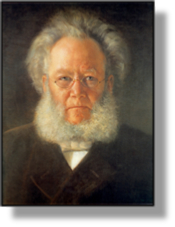 xxxxxThe Norwegian dramatist and poet Henrik Ibsen brought about a renaissance in the dramatic literature of Europe. His plays, concerned primarily with social and psychological problems, gained him recognition as the father of modern drama. His place amongst the masters of world literature was secured by his two dramatic poems Brand and Peer Gynt, produced in the 1860s, and by his cycle of realistic and, at times, controversial plays that he produced between 1877 and 1896, including A Doll’s House of 1879, Ghosts of 1882, and The Wild Duck, staged in 1884.
xxxxxThe Norwegian dramatist and poet Henrik Ibsen brought about a renaissance in the dramatic literature of Europe. His plays, concerned primarily with social and psychological problems, gained him recognition as the father of modern drama. His place amongst the masters of world literature was secured by his two dramatic poems Brand and Peer Gynt, produced in the 1860s, and by his cycle of realistic and, at times, controversial plays that he produced between 1877 and 1896, including A Doll’s House of 1879, Ghosts of 1882, and The Wild Duck, staged in 1884.
xxxxxIbsen was born at Skien, a small coastal town in southern Norway. He attended the local school and showed promise in his work, but at the age of eight his father’s business collapsed and money became tight. Forced to fend for himself, at the age of 15 he became an assistant to a chemist in Grimstad with a view to studying medicine, but he failed the entrance examination to the University of Christiania, and, as a result, turned to journalism. It was at this stage, then aged 22, that he produced his first play, Catalina, a romantic drama inspired by the revolutionary atmosphere of the day. It proved a failure at the box office, but it caught the eye of Ole Bull, a local, well-
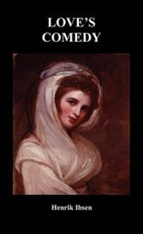 xxxxxThese years in theatre management gave him invaluable experience in all aspects of stagecraft. Furthermore, he studied the dramatic theories being put forward at this time by Hermann Hettner (1821-
xxxxxThese years in theatre management gave him invaluable experience in all aspects of stagecraft. Furthermore, he studied the dramatic theories being put forward at this time by Hermann Hettner (1821-
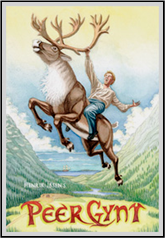 xxxxxOver the next thirty years the Ibsens lived chiefly in Italy and Germany, staying for prolonged periods in Rome, Dresden and Munich. At first they eked out a living on a travelling scholarship, but in 1866, with the enormous success of his verse tragedy Brand, Ibsen received substantial royalties and, in addition, a generous state pension from the Storting, the Norwegian parliament. The following year his poetic fantasy Peer Gynt brought in more royalties and made him financially secure. Brand told the story of a good, idealistic man, a priest, who is determined to do the right thing and suffers as a consequence. Peer Gynt, a companion piece in effect, traces the life of a completely selfish opportunist who attempts to be self-
xxxxxOver the next thirty years the Ibsens lived chiefly in Italy and Germany, staying for prolonged periods in Rome, Dresden and Munich. At first they eked out a living on a travelling scholarship, but in 1866, with the enormous success of his verse tragedy Brand, Ibsen received substantial royalties and, in addition, a generous state pension from the Storting, the Norwegian parliament. The following year his poetic fantasy Peer Gynt brought in more royalties and made him financially secure. Brand told the story of a good, idealistic man, a priest, who is determined to do the right thing and suffers as a consequence. Peer Gynt, a companion piece in effect, traces the life of a completely selfish opportunist who attempts to be self-
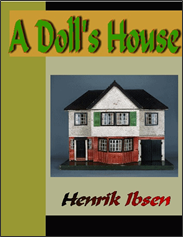 xxxxxAfter two more verse dramas, The League of Youth of 1869 and Emperor and Galilean, produced in 1873, Ibsen wrote Pillars of Society in 1875, the first of his plays centred around contemporary bourgeois life in his native Norway. There followed, over the next 15 years, A Dolls House, Ghosts, An Enemy of the People, The Wild Duck, Rosmersholm, The Lady from the Sea and, in 1890, Hedda Gabler. Particularly noteworthy among these were Pillars of Society, which focused on the life of an unscrupulous business man; A Dolls House, the story of a loveless marriage; Ghosts, a study of the effects of hereditary insanity; The
xxxxxAfter two more verse dramas, The League of Youth of 1869 and Emperor and Galilean, produced in 1873, Ibsen wrote Pillars of Society in 1875, the first of his plays centred around contemporary bourgeois life in his native Norway. There followed, over the next 15 years, A Dolls House, Ghosts, An Enemy of the People, The Wild Duck, Rosmersholm, The Lady from the Sea and, in 1890, Hedda Gabler. Particularly noteworthy among these were Pillars of Society, which focused on the life of an unscrupulous business man; A Dolls House, the story of a loveless marriage; Ghosts, a study of the effects of hereditary insanity; The 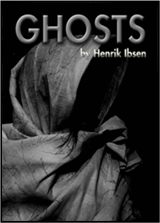 Wild Duck, a bleak tragicomedy centred around the value of truth, and Hedda Gabler, the tale and fate of a strong-
Wild Duck, a bleak tragicomedy centred around the value of truth, and Hedda Gabler, the tale and fate of a strong-
 xxxxxRecognised as a man of letters, and famous the world over, Ibsen returned to Norway in 1891. In his last cycle of plays the focus remained on the psychological study of character, and symbolism. Deftly instilled in all his earlier plays, this aspect tended to play a more prominent role. Among these works, all produced in the 1890s, were The Master Builder, Little Eyolf, John Gabriel Borkman, and When We Dead Awaken, premiered in 1899. The following year he suffered the first of a series of strokes that ended his literary career, and led to his death six years later.
xxxxxRecognised as a man of letters, and famous the world over, Ibsen returned to Norway in 1891. In his last cycle of plays the focus remained on the psychological study of character, and symbolism. Deftly instilled in all his earlier plays, this aspect tended to play a more prominent role. Among these works, all produced in the 1890s, were The Master Builder, Little Eyolf, John Gabriel Borkman, and When We Dead Awaken, premiered in 1899. The following year he suffered the first of a series of strokes that ended his literary career, and led to his death six years later.
xxxxxDuring a career spanning 50 years Ibsen wrote a great deal of poetry, much of it of a consistently high quality, but it had little influence. It was his plays, 25 in all, which have given him a lasting, worldwide reputation. Ibsen was a passionate believer in personal freedom. As a social reformer he was especially concerned with the struggle of the individual to fulfil his or her potential, free from the restraints of social and political institutions. Thus the drama in his plays was to be found in the psychological conflicts within the characters. It must be said that, at times, the symbolism in his works is obtrusive, and the depth of his psychological analysis somewhat bewildering, but his influence on the development of drama was immense. He moved away from the romantic, artificial melodramas of his era, replacing it with a stage production that challenged and questioned everyday issues of contemporary life -
xxxxxIncidentally, such was Ibsen’s fame by the late 1860s that he was chosen by the king of Sweden and Norway to represent both countries at the opening of the Suez Canal in 1869. ……
xxxxx…… At the request of Ibsen, the Norwegian composer Edvard Grieg composed the incidental music for Peer Gynt, first performed in 1876. Among the pieces for this work were Morning Mood and In the Hall of the Mountain King. ……
xxxxx…… The Irish playwright and critic George Bernard Shaw admired Ibsen’s plays, and his The Quintessence of Ibsenism, published in 1890, greatly helped to promote his works. ……
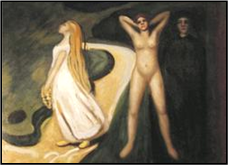
xxxxx…… Ibsen was a close friend of his fellow countryman Edvard Munch. The expressionist painter -
xxxxx…… In their different ways, the rational Ibsen and the neurotic Strindberg both influenced the development of modern drama, but they were never the best of friends. Apparently Ibsen had a portrait of Strindberg hanging above his desk. He dubbed it “Madness Incipient”, and one time confessed that he could not write a line without “that madman ..staring down at me”.
Vb-
HENRIK IBSEN 1828 -


